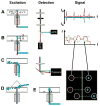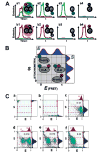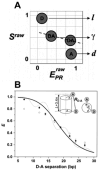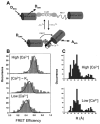Single-molecule fluorescence studies of protein folding and conformational dynamics
- PMID: 16683755
- PMCID: PMC2569857
- DOI: 10.1021/cr0404343
Single-molecule fluorescence studies of protein folding and conformational dynamics
Figures


















Similar articles
-
Application of single molecule Förster resonance energy transfer to protein folding.Methods Mol Biol. 2007;350:115-38. doi: 10.1385/1-59745-189-4:115. Methods Mol Biol. 2007. PMID: 16957321
-
Single-molecule fluorescence spectroscopy of enzyme conformational dynamics and cleavage mechanism.Proc Natl Acad Sci U S A. 1999 Feb 2;96(3):893-8. doi: 10.1073/pnas.96.3.893. Proc Natl Acad Sci U S A. 1999. PMID: 9927664 Free PMC article.
-
Probing the free-energy surface for protein folding with single-molecule fluorescence spectroscopy.Nature. 2002 Oct 17;419(6908):743-7. doi: 10.1038/nature01060. Nature. 2002. PMID: 12384704
-
Application of fluorescence spectroscopy for determining the structure and function of proteins.Pharm Biotechnol. 1995;7:1-63. doi: 10.1007/978-1-4899-1079-0_1. Pharm Biotechnol. 1995. PMID: 8564015 Review. No abstract available.
-
Shedding light on protein folding landscapes by single-molecule fluorescence.Chem Soc Rev. 2014 Feb 21;43(4):1172-88. doi: 10.1039/c3cs60311c. Chem Soc Rev. 2014. PMID: 24336839 Free PMC article. Review.
Cited by
-
Conformational Dynamics of Nonenveloped Circovirus Capsid to the Host Cell Receptor.iScience. 2020 Sep 11;23(10):101547. doi: 10.1016/j.isci.2020.101547. eCollection 2020 Oct 23. iScience. 2020. PMID: 33083716 Free PMC article.
-
Total internal reflection fluorescence microscopy imaging-guided confocal single-molecule fluorescence spectroscopy.Rev Sci Instrum. 2012 Jan;83(1):013110. doi: 10.1063/1.3677334. Rev Sci Instrum. 2012. PMID: 22299932 Free PMC article.
-
Single-molecule FRET experiments with a red-enhanced custom technology SPAD.Proc SPIE Int Soc Opt Eng. 2013 Feb 2;8590:10.1117/12.2003187. doi: 10.1117/12.2003187. Proc SPIE Int Soc Opt Eng. 2013. PMID: 24371508 Free PMC article.
-
Extending single molecule fluorescence observation time by amplitude-modulated excitation.Methods Appl Fluoresc. 2013 Sep 1;1(3):037001-37001. doi: 10.1088/2050-6120/1/3/037001. Methods Appl Fluoresc. 2013. PMID: 24587894 Free PMC article.
-
Inferring properties of disordered chains from FRET transfer efficiencies.J Chem Phys. 2018 Mar 28;148(12):123329. doi: 10.1063/1.5006954. J Chem Phys. 2018. PMID: 29604882 Free PMC article.
References
-
- Basché T, Moerner WE, Orrit M, Wild UP, editors. Single-Molecule Optical Detection, Imaging and Spectroscopy. VCH; Weinheim: 1997.
-
- Nie S, Zare RN. Annu Rev Biophys Biomol Struct. 1997;26:567. - PubMed
-
- Xie XS, Trautman JK. Annu Rev Phys Chem. 1998;49:441. - PubMed
-
- Moerner WE, Orrit M. Science. 1999;283:1670. - PubMed
-
- Weiss S. Science. 1999;283:1676. - PubMed
Publication types
MeSH terms
Substances
Grants and funding
LinkOut - more resources
Full Text Sources
Other Literature Sources

